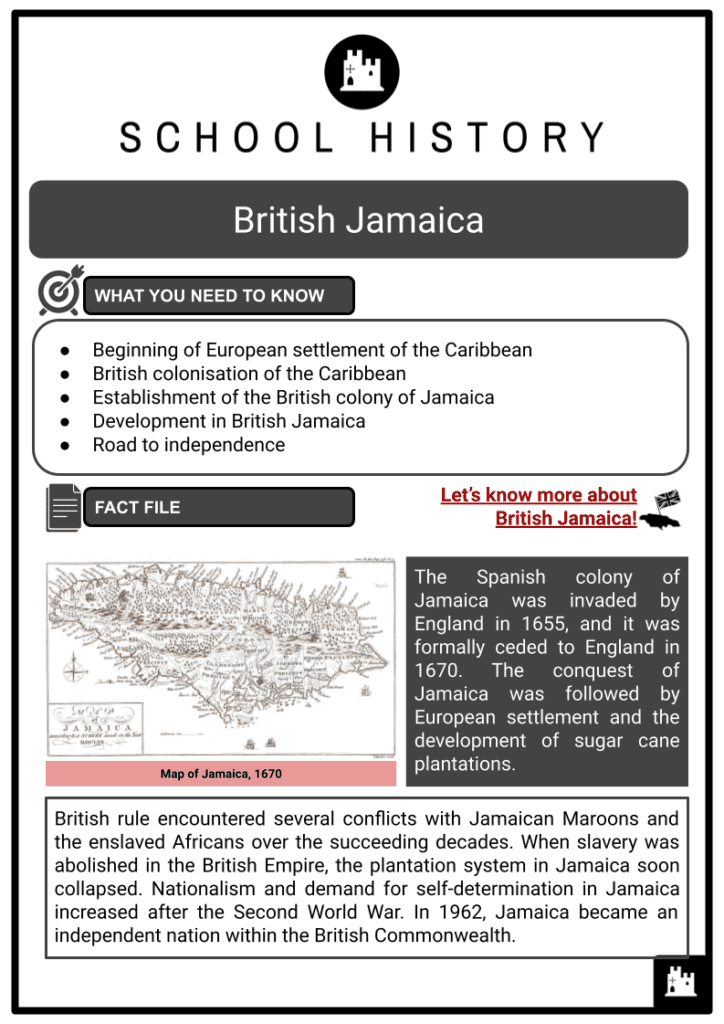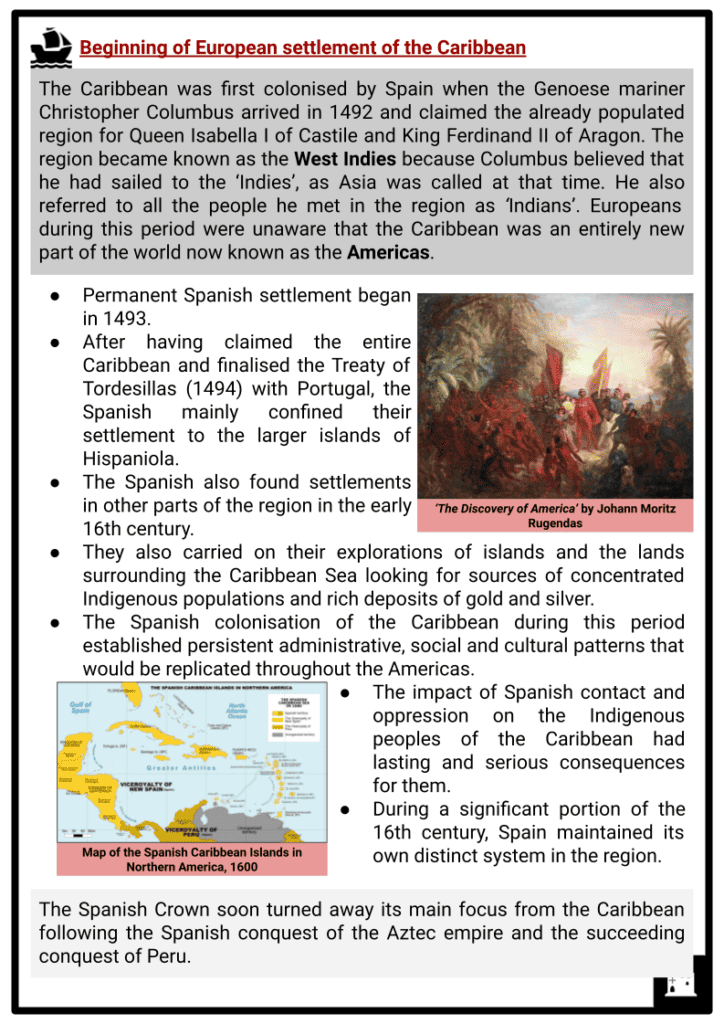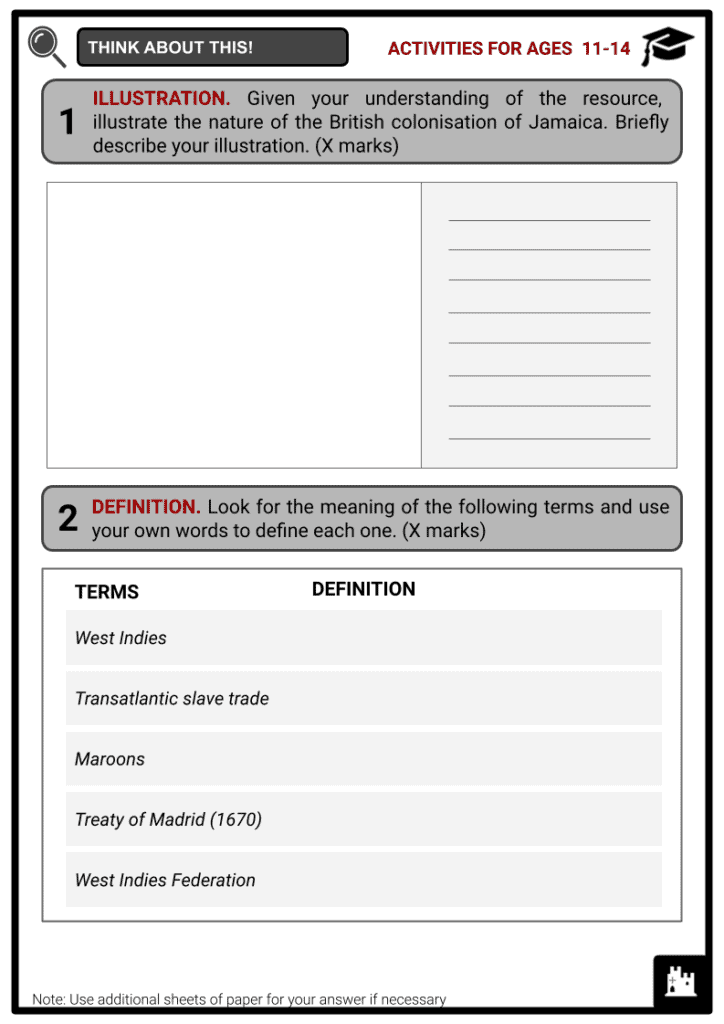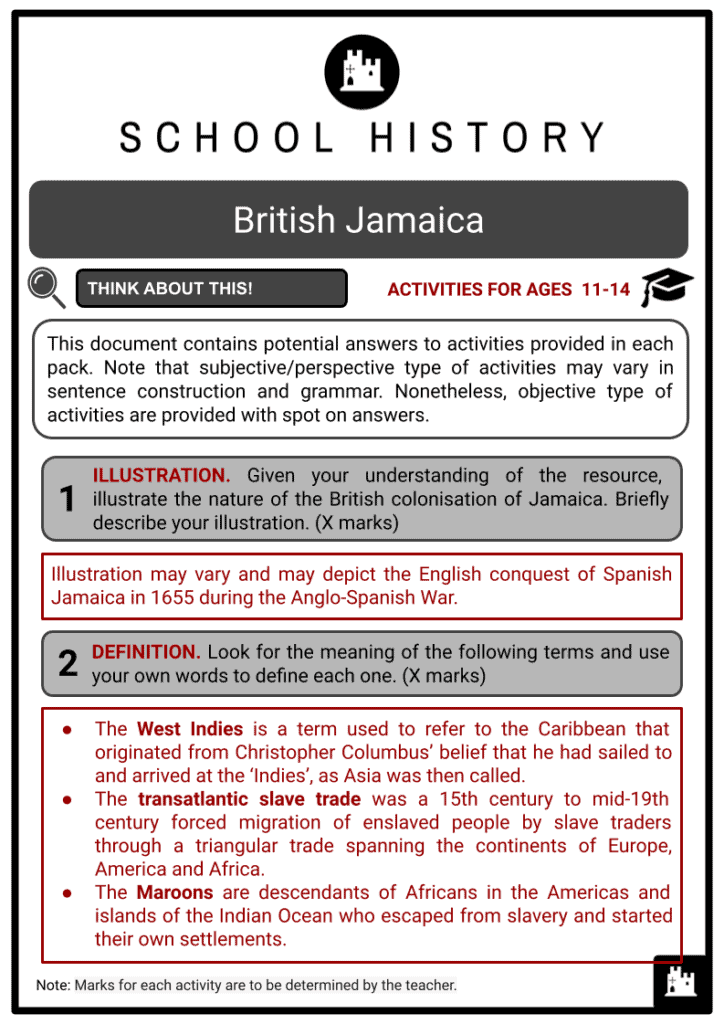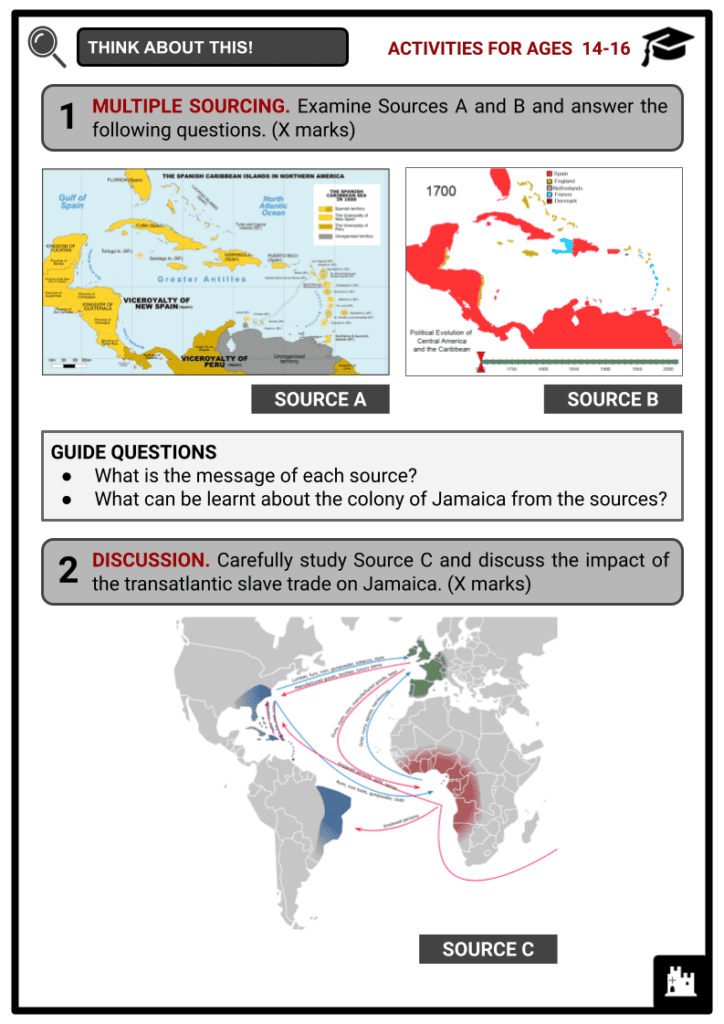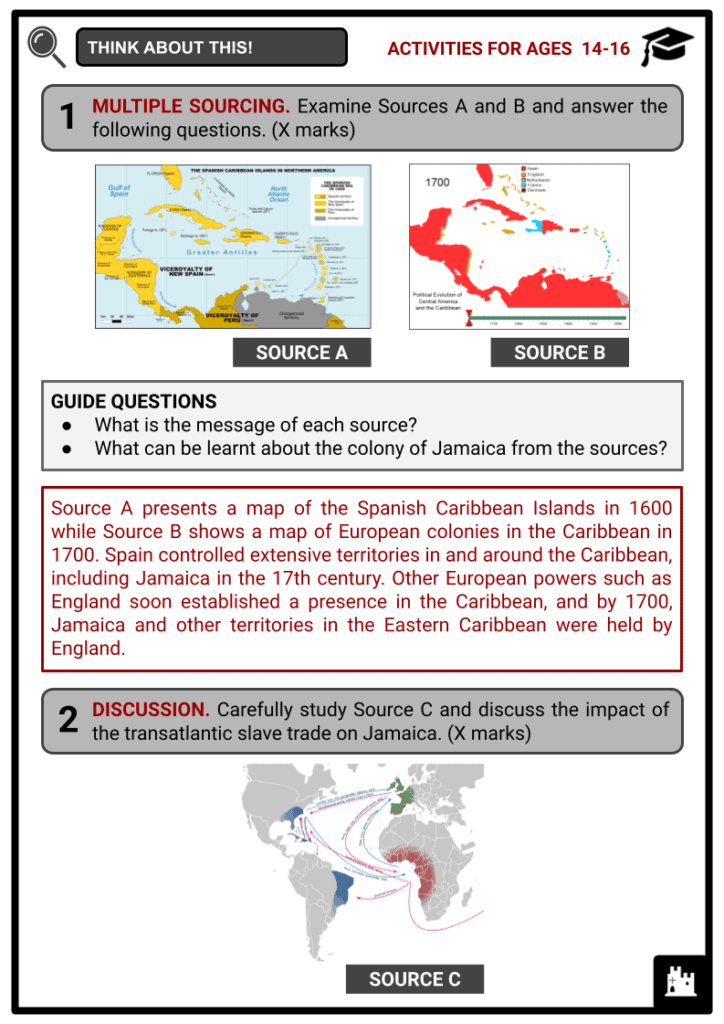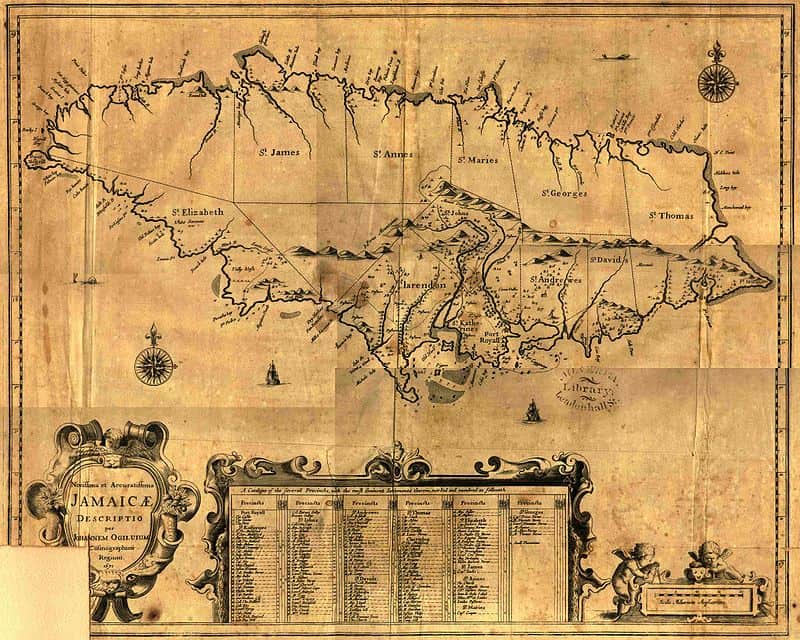British Jamaica Worksheets
Do you want to save dozens of hours in time? Get your evenings and weekends back? Be able to teach about British Jamaica to your students?
Our worksheet bundle includes a fact file and printable worksheets and student activities. Perfect for both the classroom and homeschooling!
Summary
- Beginning of European settlement of the Caribbean
- British colonisation of the Caribbean
- Establishment of the British colony of Jamaica
- Development in British Jamaica
- Road to independence
Key Facts And Information
Let’s know more about British Jamaica!
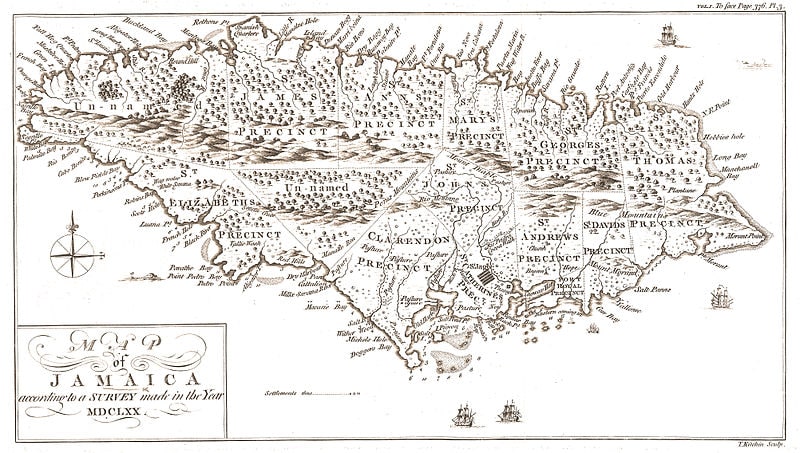
The Spanish colony of Jamaica was invaded by England in 1655 and formally ceded to England in 1670. The conquest of Jamaica was followed by European settlement and the development of sugar cane plantations. British rule encountered several conflicts with Jamaican Maroons and the enslaved Africans over the succeeding decades. When slavery was abolished in the British Empire, the plantation system in Jamaica soon collapsed. Nationalism and demand for self-determination in Jamaica increased after the Second World War. In 1962, Jamaica became an independent nation within the British Commonwealth.
Beginning of European settlement of the Caribbean
- The Caribbean was first colonised by Spain when the Genoese mariner Christopher Columbus arrived in 1492 and claimed the already populated region for Queen Isabella I of Castile and King Ferdinand II of Aragon. The region became known as the West Indies because Columbus believed that he had sailed to the ‘Indies’, as Asia was called at that time. He also referred to all the people he met in the region as ‘Indians’. Europeans during this period were unaware that the Caribbean was an entirely new part of the world now known as the Americas.
- Permanent Spanish settlement began in 1493.
- After having claimed the entire Caribbean and finalised the Treaty of Tordesillas (1494) with Portugal, the Spanish mainly confined their settlement to the larger islands of Hispaniola.
- The Spanish also found settlements in other parts of the region in the early 16th century.
- They also carried on their explorations of islands and the lands surrounding the Caribbean Sea looking for sources of concentrated Indigenous populations and rich deposits of gold and silver.
- The Spanish colonisation of the Caribbean during this period established persistent administrative, social and cultural patterns that would be replicated throughout the Americas.
- The impact of Spanish contact and oppression on the Indigenous peoples of the Caribbean had lasting and serious consequences for them.
- During a significant portion of the 16th century, Spain maintained its own distinct system in the region.
- The Spanish Crown soon turned away its main focus from the Caribbean following the Spanish conquest of the Aztec empire and the succeeding conquest of Peru.
British colonisation of the Caribbean
- Spain and Portugal practically held a monopoly over the Caribbean islands and South America. The early Spanish transatlantic voyages paved the way for further European exploration of the American continent. It was in the early 17th century that other European powers in search of wealth, such as England and France, established settlements in the Caribbean. England had shown interest in the region in the preceding century.
- In 1562, the English admiral and privateer John Hawkins attacked Portuguese merchant ships and stole 300 enslaved people who he sold illegally in the Spanish Caribbean. At the time, indentured servants were being replaced by enslaved Africans. Many privateers made their fortunes through smuggling. Hawkins made two other voyages to take advantage of the lucrative slave trade in the Caribbean in 1564–65 and 1567–69.
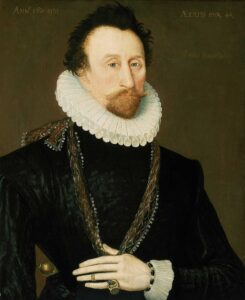
Portrait of John Hawkins - Hawkins was influential in encouraging others, including Francis Drake, to break Spain’s monopoly of trade in the Caribbean. Drake assaulted several Spanish settlements with the capture of the Spanish Silver Train at Nombre de Dios in March 1573, his most notable Caribbean exploit.
- The climate of Britain meant there were many products that could not be locally produced, including sugar and tobacco. The Caribbean was the perfect environment to grow these cash crops.
- The Caribbean islands offered European powers without colonies in the Americas the possibilities to develop sugar cane plantations based on the Spanish model, using enslaved African labourers. Additionally, the islands could also be used as bases for trade and piracy. English settlement in the Caribbean began with St Kitts in 1623, which became a base for further colonisation of the region, including Barbados, Montserrat, Antigua and Nevis.
- In 1625, a few English colonists were sent to Barbados, with the first settlement in the island beginning in 1627. The settlement was set up as a proprietary colony. The first settlers on the island included poor English people who worked as indentured labourers. Soon, hundreds of English people sailed there to make their fortunes in agriculture.
- In the 1640s, many freed indentured labourers left for the Americas as sugar cane plantations required large plots of land and expensive equipment that they were unable to afford.
- In 1655, the English had taken an interest in Jamaica and successfully overpowered the Spanish there. A significant number of Irish people, who were mostly political prisoners of war, were brought to the island as indentured labourers and soldiers. In the early 1670s, enslaved Africans formed the majority of the population as they were transported there to provide labour to the sugar cane plantations of the English.
- In 1672, the London-based Royal Africa Company was granted a charter to provide enslaved Africans for the Caribbean. Consequently, around 100,000 Africans were forced into slavery in the region between 1672 and 1689. The Company lost control of the transatlantic slave trade in 1689, enabling Bristol and Liverpool merchants to start participating in the trade.
- Between the 17th and 18th centuries, British colonisation in the Caribbean became linked to sugar cane plantations using slave labour imported from West Africa. Thousands of jobs were created in Britain by importing raw materials and exporting manufactured goods to supply to slave traders and the colonies. The wider British economy also improved, including financial, commercial, legal and insurance businesses related to the slave trade. While the slave trade brought huge profits and wealth for both Britain and the Caribbean, it had enduring and damaging effects on the Caribbean economies and, more importantly, on the Indigenous peoples of the Caribbean islands.
Establishment of the British colony of Jamaica
- The Spanish were the first Europeans who colonised Jamaica, ruling over the territory from 1494 until the mid-17th century. In 1654, England launched the Western Design expedition with the intention to acquire Spain’s colonies in the Caribbean during the Anglo-Spanish War. The invasion of Jamaica occurred the following year.
- In April 1655, the Western Design expedition commanded jointly by Admiral William Penn and Robert Venables attacked the Spanish fort at Santo Domingo, Hispaniola.
- This siege was resisted by the Spanish, and around a thousand English troops were either killed in the conflict or decimated by disease.
- By this time, the relationship between Penn and Venables had broken down.
- Following their defeat, the English force made their way to the poorly fortified Spanish Jamaica.
- In May, about 7,000 English troops arrived near Spanish Town, the capital of Jamaica, and successfully defeated the Spanish force.
- Despite being ill, Venables came ashore to set the terms that annexed the island to England. The Spanish inhabitants were ordered to leave immediately.
- While Jamaica was conquered by the English, the Western Design expedition was considered a failure, having been unable to take over Hispaniola.
- In June, Penn left for England with his fleet, followed by Venables, each intended to blame the other for the expedition’s failure. The Lord Protector of the Commonwealth, Oliver Cromwell, removed both from command.
- Meanwhile, the remaining English troops in Jamaica suffered from disease and malnutrition, and their number was significantly reduced within a year.
- The Spanish colonists fled and many enslaved Africans liberated themselves following the English conquest of Jamaica.
- The self-liberated Africans, known as Maroons, then went into the mountainous interior and set up independent Black communities.
- The Spanish allied with the Maroons to thwart English efforts to institute power over the interior and to retake the island for Spain.
- In 1656, the Treaty of Brussels was signed between Spain and the exiled monarch of England, Charles II, in which the latter pledged to return any Spanish territory captured by England.
- This, however, was not fulfilled, and so Jamaica was retained as an English possession.
- Spain continued its attempts to recapture the island with limited success. It eventually ceded the colony of Jamaica to England under the Treaty of Madrid (1670). Early English settlement in Jamaica was characterised by an increase in European population as indentured servants, prisoners and common criminals were sent to the island. The European colonists also brought with them enslaved Africans, also increasing the latter’s population.
Development in British Jamaica
- Sugar cane was first brought by the Dutch into the Caribbean in the mid-17th century and soon became the main crop in Jamaica and other islands. As sugar grew more popular in Britain, it replaced piracy as the chief source of income in Jamaica. In fact, the colony became the largest exporter of sugar in the British Empire. Sugar production boomed owing to the importation of African slave labour.
- 1692 The centre of shipping and commerce in the Caribbean Sea, Port Royal, was destroyed by an earthquake. The destruction of this trading centre, as well as the decline of the buccaneers, resulted in the growth of the adjacent fishing village of Kingston, which provided a natural harbour on the southern side of the island.
- 1728 A conflict between the Maroons and the British authorities, known as the First Maroon War, began. This erupted when Britain sent a new governor to the island.
- 1739–40 By this time, the British colonial government realised it could not suppress the Maroons. After years of fighting, peace treaties were signed between the two, under which Britain granted the Maroons political autonomy. The peace treaties also compelled the Maroons to support the institution of slavery.
- 1750 The number of sugar plantations had grown significantly. This also meant a considerable increase in the population of enslaved Africans. In fact, they numbered more than a hundred thousand by this time.
- 1760–61 Another conflict broke out, which was inspired by the First Maroon War. Tacky’s Rebellion was participated in by the enslaved Akan people and other ethnic groups from Ghana who aimed to take control of the island and establish a Black independent nation. British troops and their Maroon allies responded with attacks on the rebels, ultimately killing the leader of the rebellion. Resistance persisted for nearly a year until the remaining followers of the rebellion were either killed or captured.
- 1795–96 The Second Maroon War was fought between the Maroons of Trelawny Town and the British colonials. The Maroons waged a guerilla war, and in response, the British employed a scorched-earth strategy against them. As the Maroons had difficulty getting access to basic resources, they were forced to surrender on the condition that they would not be deported. A treaty was signed between the rivals that stipulated that the Maroons would beg on their knees for the king’s forgiveness, return all the enslaved people who escaped, and be moved elsewhere in Jamaica.
- 1807 Slave trade was abolished in the British Empire. By this time, around two million enslaved Africans had been sold to Jamaica, and tens of thousands had perished on ships in the gruelling middle passage between West Africa and the Caribbean.
- 1832 The enslaved Baptist preacher Sam Sharpe led the largest mass rebellion against slavery, known as the Baptist War. The British authorities were able to quell the rebellion, but the death toll on both sides was high.
- The reaction of the British colonial government and plantocracy proved more brutal as different forms of judicial execution went on after the rebellion was concluded. The British Parliament then held two inquiries due to the loss of property and life in the rebellion. Their reports on conditions had a significant impact on the abolition movement and the passage of the 1833 Act, which was aimed at abolishing slavery throughout the British Empire.
- 1834 Slavery was abolished in the British Empire. This was followed by the 1838 abolition of apprenticeship, a system that forced formerly enslaved people to continue to work uncompensated for their former enslavers. As the formerly enslaved Africans were no longer prepared to work for their former enslavers, the plantation system in Jamaica and other Caribbean islands soon collapsed.
- 1840 The Jamaican Assembly modified the voting qualifications in a way that would allow a significant number of Black people and people of mixed background to vote. However, the property ownership restrictions excluded the majority of non-white men from voting. As a consequence, this change in voting qualifications did not do much to change the political system of the colony.
- 1845 The sugar plantations required labourers following the emancipation of enslaved Africans. The first Indians arrived in Jamaica as indentured servants.
- 1854 The first Chinese migrants arrived in the colony as indentured servants. Most were from Hong Kong and southeast China.
- 1865 The Morant Bay Rebellion, led by the Baptist preacher Paul Bogle and joined by hundreds of formerly enslaved people, broke out due to injustice and widespread poverty. It was ruthlessly suppressed by the British. The British governor’s handling of the rebellion cost him his position.
- 1866 Jamaica was established as a Crown colony, in which the governor wielded the only real executive or legislative power. This eventually led to some social and economic development, as well as investment in infrastructure. The restored British rule also focused on agricultural development in Jamaica.
- 1870 As the sugar cane industry declined, banana plantations were set up in the colony.
- 1872 The British colonial government passed an Act to move the government offices from Spanish Town to Kingston. Kingston, which had become the largest town and the centre of trade for the colony, was made the capital of Jamaica.
- 1884 A new constitution was set up, thereby inaugurating the initial revival of local autonomy.
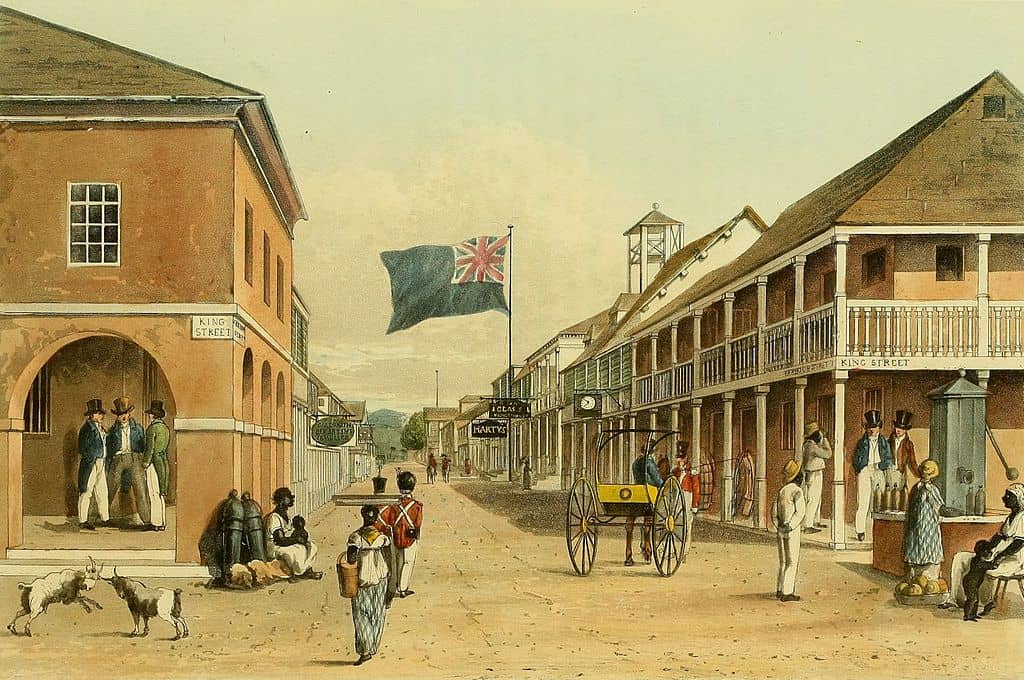
A depiction of Kingston, Jamaica - 1914 The United Negro Improvement Association was founded by Marcus Garvey with the intention to unite all of Africa and its diaspora into the organisation. Garvey believed that this would significantly improve the condition of the Black Africans.
- 1914–18 During the First World War, Jamaica emerged as a significant recruitment hub, donated a sum of £50,000 worth of sugar to Britain and set aside £10,000 for the defence of the island. The Jamaican Volunteer Defence Force, the Jamaican Constabulary Force and the Jamaica Militia artillery were all designated to protect the island during the conflict. The West India Regiment, founded in 1795 and based in Jamaica since the Napoleonic Wars, fought in the African Campaigns of the war.
- 1930s The religious and political Rastafari movement emerged among the impoverished and socially disenfranchised Afro-Jamaican communities. This movement developed after several Christian clergymen declared that the crowning of Haile Selassie as Emperor of Ethiopia in 1930 fulfilled a Biblical prophecy and merged Protestant Christianity, mysticism and a pan-African political consciousness.
- 1938 During the Depression, serious riots erupted between labourers of Frome Estate Sugar Plantation and the British authorities due to resentment against British racial policies. The police suppressed the strike with force, leading to numerous deaths of strikers and injuries on the police’s side. Similar labour unrest broke out in other Caribbean islands during this period. In Jamaica, the settlement of the riots resulted in the formation of the first lasting labour unions. It also laid the foundations for the modern party system with the establishment of the People’s National Party (PNP) and Jamaica Labour Party (JLP). There also appeared a rising demand for self-determination.
- 1939–45 During the Second World War, the largest Caribbean contingent came from Jamaica. The colony also held detention centres run by the military for thousands of displaced Europeans, military prisoners and civilian internees detained in Jamaica and other parts of British Caribbean and British West African colonies.
- 1944 Owing to the political agitation by Jamaican activists and trade union leaders, universal adult suffrage was introduced and a new constitution providing for a popularly elected House of Representatives was promulgated. The JLP won elections for the House of Representatives in the first general elections. Alexander Bustamante became the unofficial government leader. Despite these constitutional changes, the governor and other high officials still had the most power.
- 1958 The British-sponsored West Indies Federation was constituted, uniting Jamaica, Trinidad and Tobago, Barbados, and those on the Leeward and Windward Islands. The Jamaican leaders believed that the federation would be immediately granted independence from Britain.
- 1959 The PNP won a decisive victory in the general election, securing 30 of 45 House of Representatives seats. Norman Manley was appointed the first and only Premier of Jamaica. Full internal self-government was acquired.
- The period after the Second World War saw a further growth in nationalism and the demand for self-determination in Jamaica. The colony also turned out to be dissatisfied with the West Indies Federation.
Road to independence
- Membership in the British-sponsored political union grew unpopular in Jamaica. Jamaica had a smaller share of seats in the federal House of Assembly in comparison to its share of the total population of the federation. Additionally, it was responsible for a huge percentage of federal financing. Many Jamaicans believed that the smaller provinces would be a drain on the colony’s wealth, and they were dismayed that Kingston was not designated as the federal capital. Jamaica was also disappointed that independence had not yet been granted to the federation.
- Bustamante started campaigning for the colony’s withdrawal from the federation, with the intention to secure Jamaica’s independence in its own right.
- Manley preferred remaining in the federation but responded by agreeing to hold a national referendum in September 1961 to decide on the issue.
- The referendum resulted in 54.1% voting to withdraw from the federation. After Jamaica left the union, there had been attempts to save the federation. Negotiations, however, turned out to be fruitless.
- Trinidad and Tobago opted out of the federation. Without its two largest provinces that contributed significantly to the federal budget, the West Indies Federation was soon abolished.
- After losing the vote, Manley believed that the rejection of his pro-federation policy necessitated a renewed mandate from the electorate.
- In the April 1962 general election with a 72.9% voter turnout, the JLP won by a fraction. On 6 August 1962, Jamaica became an independent nation within the British Commonwealth, and Bustamante was appointed Jamaica’s first Prime Minister.
Image Sources
- https://upload.wikimedia.org/wikipedia/commons/thumb/6/60/1670_Jamaica_map_by_Kitchin.jpg/800px-1670_Jamaica_map_by_Kitchin.jpg?20140624004108
- https://upload.wikimedia.org/wikipedia/commons/thumb/0/00/John_Hawkins.JPG/800px-John_Hawkins.JPG
- https://upload.wikimedia.org/wikipedia/commons/thumb/d/d9/Jamaica1671ogilby.jpg/800px-Jamaica1671ogilby.jpg
- https://upload.wikimedia.org/wikipedia/commons/thumb/f/f6/Hakewill%2C_A_Picturesque_Tour_of_the_Island_of_Jamaica%2C_Plate_04.jpg/1024px-Hakewill%2C_A_Picturesque_Tour_of_the_Island_of_Jamaica%2C_Plate_04.jpg
Frequently Asked Questions
- Was Jamaica under the British?
The Spanish colony of Jamaica was invaded by England in 1655, and it was formally ceded to England in 1670.
- Why did the British want Jamaica?
The British saw strategic and economic value in Jamaica. Its favourable climate and fertile soil made it suitable for sugar cultivation, a lucrative industry fueled by slave labour.
- Is Jamaica still part of the British Commonwealth?
After gaining independence on 6 August 1962, Jamaica remained a member of the British Commonwealth as of 2023.

